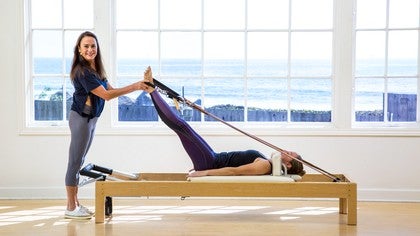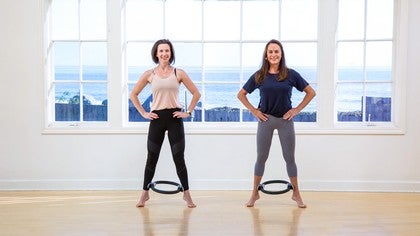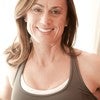Description
About This Video
Transcript
Read Full Transcript
Welcome to the discovery series. My name is Claire Dunphy Hamani and we are going to be playing off of three themes. And the first theme that we're going to do today is all about the back body. How do you find your booty? How do you work the back of the body and work that connection in all your exercises? I'm really excited about it because we are gonna discover all things about the booty because it's not what you do, but how you do it.
That really makes a difference in everything. So why about the back body? First of all, in our standing posture during the day, um, we need the back of our body to hold us upright. And so often the problems with back pain and neck pain and shoulder pain come from not having an adequate use of the back of the body. One of my teachers, many years ago, Bob leakages talked so much about, um, where the hundred and the roll-up shows up in all of the, all of the exercises.
And what I'd like to discover with you today is how the frog shows up in really unexpected places. So that's what we're going to explore today. And, um, so joining me today is the lovely Jackie and we're going to look at some of the exercises come on in, um, and starting with the reformer that help us to access the back of the body and where I often see people over clotting, you know, overusing their f their quads. Because where you put your attention in the exercise is where your energy goes. So we're going to kind of work with that and hopefully show you some hacks that will help you like Kinda, you know, tune that area up and really get into it. Okay. So we're gonna start with foot work and I'm just gonna get rid of my cap and my am I need them though. So. All right. So starting with footwork, you know, any time our heels are moving away from our seat, we have two thoughts that we could think we're either pushing away from here or we're reaching away from our seat.
So we're going to look at footwork and look at, um, I dunno. Hopefully you'll be able to show it like, right. And, and also like from a quoting perspective, but we're going to look at it from both perspectives. So here we're going to just go to our first footwork position with the toes apart, the heels together. And I'm actually gonna drop you down to three springs so that you get the feel of the pulling in. Because that's the other beauty of the frog is the, is not just the reaching out, but it's the pulling in. Because especially on the reformer, we have two choices. Like we go out, we come in.
So if we're not feeling the end and we lose 50% of the exercise, right? So we want to feel it in two directions. So let's begin, press away, push out and come in and go ahead. Just keep you skip moving and get the feel of what the reformer feels like. And Paul go and Paul and Paul and Paul.
So get your attention into your hips, pull from there, pull. And it doesn't really stop ever. So it's, and in you feel that like you kind of roll through the out to the end to the out again. Does that make sense? So rhythm and timing playing important piece in finding that little uplift of the booty and now you feel that all right, now it looks good. Now change to your arches. So when we change to the arches, we tried to find it again here in this position. So go again and in. And it was really interesting in my very early days of teaching of being a student actually in learning to teach Romano commonly would come up and she would put her hands here and in and in just to bring our attention into where we're working from. And I, coming from a background of sports and athletics, I had very overdeveloped quads and I always felt it in my quads.
And I feel like maybe some of your students do too, especially athletes and you know, so it's really hard to get out of the quads and put the attention to the back of the body and then changed here. Heels, we go and in and in and now we get to work the heel seat connection. And again, it's just like finding how the back of the body works. And I think as for your students, it's extremely helpful to help them connect to, because it directly relates to standing, walking, balancing on one foot, all those kinds of activities. And in and in and in and in. You feel that difference, right? When I get you in that rhythm, all of a sudden, Bingo, the, the lights go on and now come up to your toes and you don't have to overtalk about it cause he just, you just, it's not complicated. It's simple. But it's, I'm going to have you turn out a little bit for the lower lift, for the tendon stretch. Okay.
So let's just go out and stay out. Three counts to lower resists and three counts to lift to three, lower to three. And here you get to work on this, wrapping around from the seat, finding the inner thighs and the abdominals. But this wrapping around prevents the thighs from ruling in when the heels lower. And that's a huge anti-aging, um, important thing for people to discover because the rolling in is kind of the beginning of how people age now they start pronating, they start rolling in. And so this is a great way to keep that nice and active.
Can you feel that in there? And it Kinda holds you light on top of the reformer and it prevents you from going into your knees. So for any of you hyperextending knee people, sometimes it's hard to get into the booty. So you know by working around like that and then you think about that and you take that through to standing. Um, you know, like this is your floor. So I'm standing, that is my foot bar and I can feel where I am. Okay. And then come all the way in. Alright, so that's the first place I'm looking for that frog movement.
The next one is the actual frog. So let's go ahead and lower the foot bar. I'll lower it for you and we'll set up for the frog. I'll set these up for you. Now with the frog, it's a basic exercise and it has also advancements in the short spine massage and also in the high frog. So we're going to look at all three of those right now, right next to each other. So you can see a progression and how, um, what you want to watch for to make sure you're working your booty right. I mean, Joe [inaudible] was so brilliant in the way that he designed his exercises and one of the brilliant pieces is I think helping people do find the back of their body in their back body connections. So here we go, one and two. Okay. Knees apart, heels together and anchor your hips. All right, so first I just want to show, just pushing out in, in.
So let's go ahead and just push out and then push and come in and push and come in as hard for people like Jackie who are experienced people to, to do things incorrectly. But let this happen. Let it let it happen wrong. Like where you're really letting your knees drop to your shoulders. You see, so this now push out and then from there push out and just come in. Yeah. So can you see how her knees are dropping into her shoulders? Okay. So this is not what we want because this is not a leg press like we would do like in the gym or something. So this is different. So come in, bend your knees.
And so to find her correct position to start with is that the hips need to be anchored down. You see this nice angle here, this angle and where the straps are, that's around 45 degrees. So what I watch for as a teacher is that this spacing doesn't change so that as movements happening, the spacing of the strap to the shoulder block stays consistent. It doesn't go higher and lower. It doesn't rub because the legs are too low.
So that's kind of what we're going to work with. Okay. So go ahead and reach out, push out from your hips and come in from your hips and think about that angle. You see. So go ahead, try it on your own a couple of times out pull in, reach, pull into the powerhouse. Reach. Its not a release and push, it's a pull and it's a push and you can see in the corners of your eye the strap length. So or the strap. Keep going. Just keep it, keep it a little lower. When you come in, that's going to get you into your seat. See how it's hot? Yeah. So that's what you're working towards. And go out, see where it is.
That's a little low. There you go. Now come in and keep it right at the same spot. Now it's a little high. Okay. You see what I'm saying? So play with that and do, do a few repetitions in a row and see if you can go and keep it in motion and keep it in motion and in. And it gives, it changes your focal point. Cause everything in Polonius is all about the angles, right? And if she can do that, she's going to zero right into working from the back of the body is not cool.
You like it. Okay, so now come all the way in and we're going to take these off and just move right into the shorts. Find massage and carry this a step further. So hopefully that little strap, um, hack will help you or help your students because as soon as they know what you're looking at, then like all of a sudden they're like, oh, that's what you want me to do. You can lower your headrest and we'll take your feet inside the straps for the shorts by mustache.
Go to where you are. That's where you want to be. So all ready things are kind of in place. You set yourself up for like the right set up. So that 45 degree angle holds true here. So we go out and then you pinch two here. That's it.
Now Pinch your bottom and lift up and over. Pinch the bottom to bring you over, over, over, over this. There you go. And then bend your knees down and you roll away. So the frog part of this whole thing, relax. Let yourself move, let yourself move and then bring your heels in and your hips are down. So the first part of this movement is the, the reach and initiating the lift from the seat to get the hips overhead. So let's do it real time. Ready, go out, up and over. There you go. So this is working. There you go.
Keep pushing up into your straps to keep that working. Yeah. And then bend your knees down and then roll yourself away. Go roll, roll, roll, roll, roll free. And then bring the heels in. Okay. And finish it all the way down. So that's the thing, we have to finish the roll through the hips in order to get a clean push out of the seat and not out of the back. Okay. So it's, it seems very nuanced, but it, it's an important aspect of that before we get going again. And I think, you know, so often, like even in a group setting, I'll, I'll often see people kind of zoom through the rolling down. Then just go ahead and push out. But they're pushing from their back and not from their seat. So finishing it, almost give yourself a mental count of one or two.
Am I down and my home and then we go again. You see what I mean? Alright, so now do you know the high frog?
So the high frog way it's going to look is we'll go out, we'll go up, but you're not going to let your legs go all the way over. You're going to keep them about towards this direction and then your heels are going to go into your butt and out into your button and out and it vigorously four times. Okay? So it'll go, you'll go out and knock and then you'll go in, out and out. But not thighs to shoulders. It's going to be from the booty. Okay, so that's the, that's the trick on this one. So we go out and up and then bring your heels into your bottom and push out, out and out. There you go. Keep us up, out and out further that way towards the windows and out and come in and roll down so that you're actually, you're a good sport. So you're actually, you know, push. It's more like, um, when we do the legs, Spring's in the air on the Cadillac. It's that feeling you're up in the air and you're pushing away, pushing away, pushing away. Wonderful.
So now we're gonna move on to the shore. The, I'm sorry, the stomach massage series and look at where the frog shows up in the stomach massage series.
So your initial placement makes a huge difference in how you get yourself under and hold yourself there. We'll bring the magic into this part of the exercise. So let's get your feet up on the foot bar. Okay. Now, how about lie on your back for a second.
Go ahead and reach a lower and lift and in, there you go. Keep pulling yourself over the top while you're holding yourself under. Okay? All right. Now we'll take out a spring, but you see the position, you see the frog within there. I got your spray for you hands back. So you're going to keep this under and you're going to lift this up, lift the upper back up and we go out and lower so that usually, often what happens is people slide back or they lose their pants. So this is all part of finding this thing and pushing away from it.
Okay? So let's find your timing and your rhythm and your anchoring under and we go out and lower and lift in in and go out
And then we're going to take out a spring and reach between your legs. I'm going to let you take it and we move to the reach, reach for my shoulders, bring your back towards me and bring the carriage in. Yeah. So you're doing two things at once. You're reaching up and you're pulling in, right. And so that's an important element. So I'm going to let go. Can you stay there?
Go ahead out, come in and just read. Pull the carriage in and reach out to your back. Go Out, keep your heels up. Don't lower them. Just keep them up. Come in and reach and go out. Reach for me. Reach and reach. When you go out, keep reaching, keep reaching. Can you reach for me? Yes. And one more time.
Stay there. You reach. Reach more, reach more. And at the same time you're doing this and you're doing this and you're doing this. There's a lot going on there and come all the way in and reach. Wonderful. Step off to the side. And that's where you get the work because it's not what you do, but how you do it. It's like kind of, that's why it's discovering.
It's like I'm discovering how tall can I get? How much can I lift to make it harder for me to get in? You know, all of those kinds of things. And that's kind of it alone. I think I'm like a little bit nerdy about it, but I think it's so much fun. Um, okay, so the next exercise we're going to look at is the knee stretch series, knees off, which is another place where people always think about, oh, my quads, my quads, my darn quads is not about the quads. It's about your booty. So let's come into a kneeling position, rounded to start with.
Okay? So you're really, really rounded here. Okay. So the tail is pulling under. Sit a little closer to your heels until you feel my thumbnail touching. You quit. Okay. Right there. This stays lifted. So this, these under, so when she pushes back, we're trying to get her into the back of her hips. So this, none of this is going to change our goal.
Our goal is that none of that is going to change. You're ready? Wait a minute. You're going to take your knees off. You're ready, lift up, lift your knees and push out at the same time and push. Push up
Okay? So the typical thing that starts to happen is that shoulders drop in the hips. Lift. Can you show us the incorrect way? Can you stick your butt up in the air and show what people kind of like to do? They like to push out. Go ahead out.
And then from here where their hips and their shoulders get the same height and that's not gonna do anything for the booty. That's just going to over and you can relax. That's just going to overdo the quads that much more. So that's another place where sort of this frog movement is showing up. Now step off and let's go on and let's say we're going through the end of the regular order. We also have, um, pelvic lift, which is another place where the frog occurs.
So add two springs please and come onto your back. And what I find really interesting is that the, um, the pelvic lift towards the end of the workout, um, it is bringing back everything we started with. So it reengages the booty again and prepares us for the splits. So go to your arches, turn out, there you go. So you're up. Yep.
And so let your knees open out and curl your pelvis up. So basically your frog is anything you do where your heels are moving away from your seat, so that curl this up. So what you want to see here is that that pubic bone is actually than the hip bones. The low back is round and under, it's not hanging. So she showing that beautifully. So now show that the other way lower. You just sort of like drop that. Yeah. Okay.
Lift up a little too high like that. Cause now she doesn't really have to use the back of her body in quite the same way. So go into the correct position where this is down and come down. The measurement traditionally is about hand distance, like so if you've made a prayer position and slid it under your back, but she's perfect. So now she's gonna push away and she's going to pull in resisting all the way in, pull all the way in, get the feeling of pulling in as soon as the springs start to undo. Now come a little lower. Keep going. Just keep yourself low and long. Yeah, low and long. So all of those bar classes that people do, this is a great little tool that you can carry into your bar classes that allows you to work your plea a in the correct way.
Okay, and in, don't go into the back of the knees, we're getting you out of your quads. Get into the back here and resist. All I'm doing is I'm pressing her open a little so she has to push up more from the right place. She is smiling by the way and hold and then curl down while you're pulling the kerogen. Yeah. You see the difference? Like when I do that, you had to find your inner size. We're going to find your seat. So the frog on the reformer shows up in those places and probably more that you can think of. But now we're going to take a look at where the shot frog appears, um, on the chair. Okay.
So let's take a peek at the how the back of the body works in some common mat exercises. So we're going to take a look at the AB series. So I'm, where the frog shows up once again is anytime the heels are moving away from the seat. So we kind of want that to happen in a direct line. And very often people kind of make, uh, an indirect line, like they go up and down with their leg and they never really get into their booty and into the back of their body. So let's take a quick look at that now. Okay, so come down now getting into the booty. There's a couple of tricks I use that I other people find useful.
And that is finding the center line, using the inner thighs, wrapping it around in the seat and pulling up in the belly. So let's just start with your left knee into your chest and your right leg extended so the cameras can see. So if the leg just drops too low and hangs the back of the leg, it doesn't have to work at all. So ideally you're gonna work this right at eye level and then instead of locking the knee and just straightening the knee, wrapping around in the seat. Okay. So then when we go to change legs, reach the heel in a direct line out from the seat wraparound. Yeah. And change wrap around in the seat.
Now as she's pulling and reaching, she's wrapping this around and you can see it pretty easily when you're, when you have people up on a chair. So change again and change and change and change and change. Good. And just by poking around, I can feel that these muscles are engaging. So both knees into your chest and we'll go to the double leg stretch, take a grab to your ankles with your hands. So she's pulling her heels into her seat.
And then when she reaches her legs away, she's going to push from her buttocks instead of just straightening her legs. Okay. It's like a little different focus. So where your focus goes, your energy flows. Ready, reach the heels away, wrap around and reach, and then come around and pull in and inhale and reach the heels from the seat. And around an in. And when I'm looking is if there's a direct line, reach a direct line out and come run and I'll show it where you know, you've seen it, where people kind of go up and down and they up and dip and then they come in. No. Now if you want to advance that, you can actually do almost like a reverse bicycle. So you go ahead and reach out and reach their heels down and away and out.
Do you know, have you ever seen that? And so you reached down in a way and out and then come in. And now let's take your right leg up, your left leg out. And so here we have, how the center line helps you is incredible. Get the legs like you're standing on a balance beam and change legs and pull the leg down from the seat and change and pull. Pull.
So you're pulling, but you're reaching with the other leg. It doesn't fall down. In other words, pull, pull, and pull. Pull. Now can you show dropping of a leg? I don't even know if you can let it fall and go. Yeah. Where? It just relaxes change. So it just falls down. Nothing's happening.
Why bother then? Right? So take your hands behind your head. Stretch your legs to the ceiling. Okay, so she's wrapped around, wrap around here in your seat even more. And the wraparound is not just a turnout, it's an action of the seat. It's not just like an artificial rotation. Okay? So bring your legs out. Once you get to 45 degrees, use your bottom to pull the legs down, and then you lift them up.
She's smiling. That's a good thing. So reach a 45 that you use your bottom to pull the legs even lower than the level and come up. Now Chris Cross to the right and we're only doing a couple, right? So you're reaching and change to the left. So this is all frog movements, even though it's the Ab series, the frog lives within so many of these exercises and rest and come up.
Nice job. I think the main thing is that you see the line you're going for, you see the work that's in there. Because see, anybody who over quads when they're working isn't doing two things. They're either not reaching from their seat or not lengthening out over the top. And so it's really hard to let go of over clenching the legs. It's just, especially if you're an athlete, you know, so your bicycle rider or if you're a runner, it's, it's so, it's, so there's a few things in play. It's, it's getting that from the back, lengthening it from the front, and finding a tempo that doesn't allow you to over tense your body. So good. Great demonstration.
Now we're going to go over to the chair and we're going to look at like where the frog shows up in the chair. We have so many frogs in the chair of the arm, frog, the supine frog, all these, but it also starts right from the footwork. So let's go ahead and have a seat. And um, right starting from pumping. So you're on your toes, toes apart, heels together, the same as the foot work essentially, right? Just fold your arms in front of your chest and you want to lean forward a little bit so that you're kind of a little in that zone of like, whoa.
Okay. It's very safe back there. Pull yourself forward when you're doing this and your abs really kick in. So part of the chair work is closing the spring, the same as the reformer, resisting the return and not just letting it pop you up, you know, so keeping everything lifted. Let's see some frog action. Pull the pedal up, pull it up into your hips, into your belly and up and up. But not, uh, bouncing up, uh, pulling up like that. Pull it up and now get into a rhythm that's not over controlled. So like sometimes in an effort to be like in control, we're over controlling and that's just builds tension, right? So find out, up and up and up and uh, changed here.
Arches. We're not gonna do full reps. Go to your arch of your feet and we go up and up, squeezing the legs together, activating the inner thighs, using the seat and pulling up into the belly. Those three magical places, you know, it's like a Unicorn, you that together in your body and that's where the magic lives. And then go up to your heels, give it a little bit more, a little more rhythm
And I guess, you know, you see it, it's like all of a sudden the body's enlivened. Wonderful. Okay, so now, so that's where the frog lives here and you, you, you can totally get yourself transformed into using the back of the body when you think about the back of the body step off. So the next thing we're going to look at is just standing pumping. So okay, just come upstairs and you have choice where you want to put your hands so you can have on your hips to the side behind your head up in the air. So wherever you like to have them.
But the one thing I want to talk about in terms of posture with regard to this is to make sure that the shoulders, the weight of the shoulders isn't being carried over the heels. The weight of the shoulders is carried over the ball of the foot, the hips are, are under, not behind. So that already on the standing leg, which is going to be the theme of another tutorials, like what about that standing like also is going to be important in this one, but here it's that pumping leg that we're going to be working the frog aspect of the movement. So can you switch legs for me so that way the camera sees, okay, so the heel is halfway up to the maximum amount and she squared off. And then from the side we can see that her, she's holding the weight of her shoulders more over the ball of the foot.
And then bring this under you a little bit. There you go. So the standing leg is working and now go, let's pump from here. Press lift, oopsies and up. So you control it and you know, it takes a few to kind of get into it, but all of a sudden, anytime, like I said, the frog is anywhere in space that your heel is moving away from your bottom
Let's take a look at the tabletop. So how does seat and the tabletop is an interesting um, exercise because you're doing two things at once. Once we get up into the position, you're pushing your hips up as you're pushing the pedal away. So it's direct opposition to get you right up into your, into your bottom. So to start with, you can bring your hands around the back of this chair and you can turn out a little bit.
And this can be done in a turned out position or a parallel position. And it's good to do them in both. But for us today, I'm just going to do it like this. Keep the pedal up, lift your hips up and forward over your heels more towards me. That's it. Now keep pushing up into my hands and go ahead. 10 pumps and up and up and up and up and up. Pull it up. Keep this up, up and up. That's enough and have a seat.
And that's a lot of work, right? Cause you're dry. Now, if you feel it in your hamstrings and you don't feel it in your butt, try again because that's what we want. There's a thing that's been floating around the fitness industry. I don't know if you've heard about it or not, called gluteal amnesia. And it's this idea we sit on our bottoms so much that our bodies have forgotten how to use our glutes as a part of our movement habits and movement patterns. And so, um, so this is a great one for that because it really, but if, again, if you feel only in your hamstrings, you've got a little more work to do in boosting the, the pelvis up and forward mountain climb is going to have the same concept that going up front is going to have the same concept in terms of where you're pushing and pulling from.
So I hope you got a little bit more to work with and a little bit to chew on in figuring out your, you know, finding the back body and helping your clients find the back body in terms of their posture and all of the wonderful places that the frog lives in the plotty system. So thanks for joining me today and I hope you enjoy the rest of the discovery series.
The Teacher's Corner: The Discovery Series
Comments
You need to be a subscriber to post a comment.
Please Log In or Create an Account to start your free trial.





















